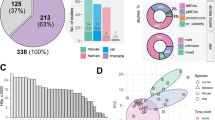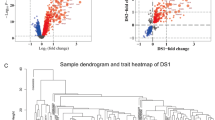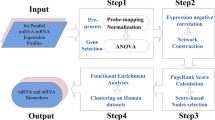Abstract
Neuroprotection in acute stroke has not been successfully translated from animals to humans. Animal research on promising agents continues largely in rats and mice which are commonly available to researchers. However, controversies continue on the most suitable species to model the human situation. Generally, putative agents seem less effective in mice as compared with rats. We hypothesized that this may be due to inter-species differences in stroke response and that this might be manifest at a genetic level. Here we used whole-genome microarrays to examine the differential gene regulation in the ischemic penumbra of mice and rats at 2 and 6 h after permanent middle cerebral artery occlusion (pMCAO; Raw microarray CEL data files are available in the GEO database with an accession number GSE163654). Differentially expressed genes (adj. p ≤ 0.05) were organized by hierarchical clustering, correlation plots, Venn diagrams and pathway analyses in each species and at each time-point. Emphasis was placed on genes already known to be associated with stroke, including validation by RT-PCR. Gene expression patterns in the ischemic penumbra differed strikingly between the species at both 2 h and 6 h. Nearly 90% of significantly regulated genes and most pathways modulated by ischemia differed between mice and rats. These differences were evident globally, among stroke-associated genes, immediate early genes, genes implicated in stress response, inflammation, neuroprotection, ion channels, and signal transduction. The findings of this study may have significant implications for the choice of species for screening putative stroke therapies.


Similar content being viewed by others
Data Availability
All data in this paper are available to scientific communities upon reasonable request to the corresponding author.
References
Aarts M, Liu Y, Liu L, Besshoh S, Arundine M, Gurd JW, Wang YT, Salter MW, Tymianski M (2002) Treatment of ischemic brain damage by perturbing NMDA receptor- PSD-95 protein interactions. Science 298(5594):846–850. https://doi.org/10.1126/science.1072873
Bach A, Clausen BH, Moller M, Vestergaard B, Chi CN, Round A, Sorensen PL, Nissen KB, Kastrup JS, Gajhede M, Jemth P, Kristensen AS, Lundstrom P, Lambertsen KL, Stromgaard K (2012) A high-affinity, dimeric inhibitor of PSD-95 bivalently interacts with PDZ1-2 and protects against ischemic brain damage. Proc Natl Acad Sci U S A 109(9):3317–3322. https://doi.org/10.1073/pnas.1113761109
Bederson JB, Pitts LH, Tsuji M, Nishimura MC, Davis RL, Bartkowski H (1986) Rat middle cerebral artery occlusion: evaluation of the model and development of a neurologic examination. Stroke 17(3):472–476. https://doi.org/10.1161/01.str.17.3.472
Bratane BT, Cui H, Cook DJ, Bouley J, Tymianski M, Fisher M (2011) Neuroprotection by freezing ischemic penumbra evolution without cerebral blood flow augmentation with a postsynaptic density-95 protein inhibitor. Stroke 42(11):3265–3270. https://doi.org/10.1161/STROKEAHA.111.618801
Carmichael ST (2005) Rodent models of focal stroke: size, mechanism, and purpose. NeuroRx 2(3):396–409. https://doi.org/10.1602/neurorx.2.3.396
Chelluboina B, Warhekar A, Dillard M, Klopfenstein JD, Pinson DM, Wang DZ, Veeravalli KK (2015) Post-transcriptional inactivation of matrix metalloproteinase-12 after focal cerebral ischemia attenuates brain damage. Sci Rep 5:9504. https://doi.org/10.1038/srep09504
Choy FC, Klaric TS, Leong WK, Koblar SA, Lewis MD (2016) Reduction of the neuroprotective transcription factor Npas4 results in increased neuronal necrosis, inflammation and brain lesion size following ischaemia. J Cereb Blood Flow Metab 36(8):1449–1463. https://doi.org/10.1177/0271678X15606146
Clark WM, Lessov NS, Dixon MP, Eckenstein F (1997) Monofilament intraluminal middle cerebral artery occlusion in the mouse. Neurol Res 19(6):641–648. https://doi.org/10.1080/01616412.1997.11740874
Cook, D. J., Teves, L., & Tymianski, M. (2012a). A translational paradigm for the preclinical evaluation of the stroke neuroprotectant Tat-NR2B9c in gyrencephalic nonhuman primates. Sci Transl Med, 4(154), 154ra133. https://doi.org/10.1126/scitranslmed.3003824
Cook DJ, Teves L, Tymianski M (2012b) Treatment of stroke with a PSD-95 inhibitor in the gyrencephalic primate brain. Nature 483(7388):213–217. https://doi.org/10.1038/nature10841
Cox-Limpens KE, Gavilanes AW, Zimmermann LJ, Vles JS (2014) Endogenous brain protection: what the cerebral transcriptome teaches us. Brain Res 1564:85–100. https://doi.org/10.1016/j.brainres.2014.04.001
Cuadrado E, Rosell A, Penalba A, Slevin M, Alvarez-Sabin J, Ortega-Aznar A, Montaner J (2009) Vascular MMP-9/TIMP-2 and neuronal MMP-10 up-regulation in human brain after stroke: a combined laser microdissection and protein array study. J Proteome Res 8(6):3191–3197. https://doi.org/10.1021/pr801012x
Cunningham LA, Wetzel M, Rosenberg GA (2005) Multiple roles for MMPs and TIMPs in cerebral ischemia. Glia 50(4):329–339. https://doi.org/10.1002/glia.20169
Du Y, Deng W, Wang Z, Ning M, Zhang W, Zhou Y, Lo EH, Xing C (2017) Differential subnetwork of chemokines/cytokines in human, mouse, and rat brain cells after oxygen-glucose deprivation. J Cereb Blood Flow Metab 37(4):1425–1434. https://doi.org/10.1177/0271678X16656199
Dziewulska D, Mossakowski MJ (2003) Cellular expression of tumor necrosis factor a and its receptors in human ischemic stroke. Clin Neuropathol 22(1):35–40
Esser JS, Charlet A, Schmidt M, Heck S, Allen A, Lother A, Epting D, Patterson C, Bode C, Moser M (2017) The neuronal transcription factor NPAS4 is a strong inducer of sprouting angiogenesis and tip cell formation. Cardiovasc Res 113(2):222–223. https://doi.org/10.1093/cvr/cvw248
Fisher, M., Feuerstein, G., Howells, D. W., Hurn, P. D., Kent, T. A., Savitz, S. I., Lo, E. H., & Group, S (2009) Update of the stroke therapy academic industry roundtable preclinical recommendations. Stroke 40(6):2244–2250. https://doi.org/10.1161/STROKEAHA.108.541128
Harada H, Wang Y, Mishima Y, Uehara N, Makaya T, Kano T (2005) A novel method of detecting rCBF with laser-Doppler flowmetry without cranial window through the skull for a MCAO rat model. Brain Res Brain Res Protoc 14(3):165–170. https://doi.org/10.1016/j.brainresprot.2004.12.007
Henninger N, Bouley J, Bratane BT, Bastan B, Shea M, Fisher M (2009) Laser Doppler flowmetry predicts occlusion but not tPA-mediated reperfusion success after rat embolic stroke. Exp Neurol 215(2):290–297. https://doi.org/10.1016/j.expneurol.2008.10.013
Hill MD, Goyal M, Menon BK, Nogueira RG, McTaggart RA, Demchuk AM, Poppe AY, Buck BH, Field TS, Dowlatshahi D, van Adel BA, Swartz RH, Shah RA, Sauvageau E, Zerna C, Ospel JM, Joshi M, Almekhlafi MA, Ryckborst KJ, Lowerison MW, Heard K, Garman D, Haussen D, Cutting SM, Coutts SB, Roy D, Rempel JL, Rohr AC, Iancu D, Sahlas DJ, Yu AYX, Devlin TG, Hanel RA, Puetz V, Silver FL, Campbell BCV, Chapot R, Teitelbaum J, Mandzia JL, Kleinig TJ, Turkel-Parrella D, Heck D, Kelly ME, Bharatha A, Bang OY, Jadhav A, Gupta R, Frei DF, Tarpley JW, McDougall CG, Holmin S, Rha JH, Puri AS, Camden MC, Thomalla G, Choe H, Phillips SJ, Schindler JL, Thornton J, Nagel S, Heo JH, Sohn SI, Psychogios MN, Budzik RF, Starkman S, Martin CO, Burns PA, Murphy S, Lopez GA, English J, Tymianski M, Investigators E-N (2020) Efficacy and safety of nerinetide for the treatment of acute ischaemic stroke (ESCAPE-NA1): a multicentre, double-blind, randomised controlled trial. Lancet 395(10227):878–887. https://doi.org/10.1016/S0140-6736(20)30258-0
Hill MD, Martin RH, Mikulis D, Wong JH, Silver FL, Terbrugge KG, Milot G, Clark WM, Macdonald RL, Kelly ME, Boulton M, Fleetwood I, McDougall C, Gunnarsson T, Chow M, Lum C, Dodd R, Poublanc J, Krings T, Demchuk AM, Goyal M, Anderson R, Bishop J, Garman D, Tymianski M, investigators, E. t. (2012) Safety and efficacy of NA-1 in patients with iatrogenic stroke after endovascular aneurysm repair (ENACT): a phase 2, randomised, double-blind, placebo-controlled trial. Lancet Neurol 11(11):942–950. https://doi.org/10.1016/S1474-4422(12)70225-9
Hori M, Nakamachi T, Rakwal R, Shibato J, Nakamura K, Wada Y, Tsuchikawa D, Yoshikawa A, Tamaki K, Shioda S (2012) Unraveling the ischemic brain transcriptome in a permanent middle cerebral artery occlusion mouse model by DNA microarray analysis. Dis Model Mech 5(2):270–283. https://doi.org/10.1242/dmm.008276
Kilkenny C, Browne WJ, Cuthill IC, Emerson M, Altman DG (2010) Improving bioscience research reporting: the ARRIVE guidelines for reporting animal research. PLoS Biol 8(6):e1000412. https://doi.org/10.1371/journal.pbio.1000412
Kleinschnitz C, Mencl S, Kleikers PWM, Schuhmann MK, Lopez MG, Casas AI, Surun B, Reif A, Schmidt H (2016) NOS knockout or inhibition but not disrupting PSD-95-NOS interaction protect against ischemic brain damage. J Cereb Blood Flow Metab 36(9):1508–1512. https://doi.org/10.1177/0271678X16657094
Koizumi J-I, Yoshida Y, Nakazawa T, Ooneda G (1986) Experimental studies of ischemic brain edema 1: a new experimental model of cerebral embolism in rats in which recirculation can be introduced in the ischemic area. Nosotchu 8(1):1–8. https://doi.org/10.3995/jstroke.8.1
Lambertsen KL, Biber K, Finsen B (2012) Inflammatory cytokines in experimental and human stroke. J Cereb Blood Flow Metab 32(9):1677–1698. https://doi.org/10.1038/jcbfm.2012.88
Llovera G, Hofmann K, Roth S, Salas-Perdomo A, Ferrer-Ferrer M, Perego C, Zanier ER, Mamrak U, Rex A, Party H, Agin V, Fauchon C, Orset C, Haelewyn B, De Simoni MG, Dirnagl U, Grittner U, Planas AM, Plesnila N, Vivien D, Liesz A (2015) Results of a preclinical randomized controlled multicenter trial (pRCT): Anti-CD49d treatment for acute brain ischemia. Sci Transl Med 7(299):299ra121. https://doi.org/10.1126/scitranslmed.aaa9853
Longa EZ, Weinstein PR, Carlson S, Cummins R (1989) Reversible middle cerebral artery occlusion without craniectomy in rats. Stroke 20(1):84–91. https://doi.org/10.1161/01.str.20.1.84
Lu H, Hu H, He Z, Han X, Chen J, Tu R (2012) Therapeutic imaging window of cerebral infarction revealed by multisequence magnetic resonance imaging: an animal and clinical study. Neural Regen Res 7(31):2446–2455. https://doi.org/10.3969/j.issn.1673-5374.2012.31.006
Maas MB, Furie KL (2009) Molecular biomarkers in stroke diagnosis and prognosis. Biomark Med 3(4):363–383. https://doi.org/10.2217/bmm.09.30
Mayer MP, Bukau B (2005) Hsp70 chaperones: cellular functions and molecular mechanism. Cell Mol Life Sci 62(6):670–684. https://doi.org/10.1007/s00018-004-4464-6
Pandi G, Nakka VP, Dharap A, Roopra A, Vemuganti R (2013) MicroRNA miR-29c down-regulation leading to de-repression of its target DNA methyltransferase 3a promotes ischemic brain damage. PLoS ONE 8(3):e58039. https://doi.org/10.1371/journal.pone.0058039
Peng Z, Li J, Li Y, Yang X, Feng S, Han S, Li J (2013) Downregulation of miR-181b in mouse brain following ischemic stroke induces neuroprotection against ischemic injury through targeting heat shock protein A5 and ubiquitin carboxyl-terminal hydrolase isozyme L1. J Neurosci Res 91(10):1349–1362. https://doi.org/10.1002/jnr.23255
Pruunsild P, Sepp M, Orav E, Koppel I, Timmusk T (2011) Identification of cis-elements and transcription factors regulating neuronal activity-dependent transcription of human BDNF gene. J Neurosci 31(9):3295–3308. https://doi.org/10.1523/JNEUROSCI.4540-10.2011
Ramos-Cejudo J, Gutierrez-Fernandez M, Rodriguez-Frutos B, Exposito Alcaide M, Sanchez-Cabo F, Dopazo A, Diez-Tejedor E (2012) Spatial and temporal gene expression differences in core and periinfarct areas in experimental stroke: a microarray analysis. PLoS ONE 7(12):e52121. https://doi.org/10.1371/journal.pone.0052121
Sairanen T, Carpen O, Karjalainen-Lindsberg ML, Paetau A, Turpeinen U, Kaste M, Lindsberg PJ (2001) Evolution of cerebral tumor necrosis factor-alpha production during human ischemic stroke. Stroke 32(8):1750–1758. https://doi.org/10.1161/01.str.32.8.1750
Selvamani A, Sathyan P, Miranda RC, Sohrabji F (2012) An antagomir to microRNA Let7f promotes neuroprotection in an ischemic stroke model. PLoS ONE 7(2):e32662. https://doi.org/10.1371/journal.pone.0032662
Industry STA, R. (1999) Recommendations for standards regarding preclinical neuroprotective and restorative drug development. Stroke 30(12):2752–2758. https://doi.org/10.1161/01.str.30.12.2752
Sun J, Nan G (2016) The mitogen-activated protein kinase (MAPK) signaling pathway as a discovery target in stroke. J Mol Neurosci 59(1):90–98. https://doi.org/10.1007/s12031-016-0717-8
Taghibiglou C, Martin HG, Lai TW, Cho T, Prasad S, Kojic L, Lu J, Liu Y, Lo E, Zhang S, Wu JZ, Li YP, Wen YH, Imm JH, Cynader MS, Wang YT (2009) Role of NMDA receptor-dependent activation of SREBP1 in excitotoxic and ischemic neuronal injuries. Nat Med 15(12):1399–1406. https://doi.org/10.1038/nm.2064
Tejima E, Guo S, Murata Y, Arai K, Lok J, van Leyen K, Rosell A, Wang X, Lo EH (2009) Neuroprotective effects of overexpressing tissue inhibitor of metalloproteinase TIMP-1. J Neurotrauma 26(11):1935–1941. https://doi.org/10.1089/neu.2009-0959
Teves LM, Cui H, Tymianski M (2016) Efficacy of the PSD95 inhibitor Tat-NR2B9c in mice requires dose translation between species. J Cereb Blood Flow Metab 36(3):555–561. https://doi.org/10.1177/0271678X15612099
Tymianski M (2015) Neuroprotective therapies: Preclinical reproducibility is only part of the problem. Sci Transl Med 7(299):299fs232. https://doi.org/10.1126/scitranslmed.aac9412
Weiss JB, Eisenhardt SU, Stark GB, Bode C, Moser M, Grundmann S (2012) MicroRNAs in ischemia-reperfusion injury. Am J Cardiovasc Dis 2(3):237–247
Welten SM, Bastiaansen AJ, de Jong RC, de Vries MR, Peters EA, Boonstra MC, Sheikh SP, La Monica N, Kandimalla ER, Quax PH, Nossent AY (2014) Inhibition of 14q32 MicroRNAs miR-329, miR-487b, miR-494, and miR-495 increases neovascularization and blood flow recovery after ischemia. Circ Res 115(8):696–708. https://doi.org/10.1161/CIRCRESAHA.114.304747
Yang L, Xiong Y, Hu XF, Du YH (2015) MicroRNA-323 regulates ischemia/reperfusion injury-induced neuronal cell death by targeting BRI3. Int J Clin Exp Pathol 8(9):10725–10733
Zhou HH, Tang Y, Zhang XY, Luo CX, Gao LY, Wu HY, Chang L, Zhu DY (2015) Delayed administration of Tat-HA-NR2B9c promotes recovery after stroke in rats. Stroke 46(5):1352–1358. https://doi.org/10.1161/STROKEAHA.115.008886
Acknowledgements
We thank Dr. Lu-Yang Wang and Dr. Michael Salter for their critical review.
Funding
This work was supported by funds from the Canada Research Chairs program.
Author information
Authors and Affiliations
Contributions
MT, QJW, XS, designed the experiments. QJW, XS, LT and DM performed the experiments. QJW and MT wrote the manuscript.
Corresponding author
Ethics declarations
Conflict of interest
Dr. Michael Tymianski (M.T.) is a Canada Research Chair (Tier 1) in Translational Stroke Research, and the CEO of NoNO Inc., a biotechnology company developing nerinetide (also termed NA-1 or Tat-NR2B9c) for clinical use. Q.J.W., X.J.S., L.T. and D.M. have no competing interests.
Ethical Approval
All procedures performed involving animals were approved by the University Health Network animal care committee, conformed to Canadian Council of Animal Care guidelines, and ARRIVE guidelines (Kilkenny et al. 2010).
Additional information
Publisher's Note
Springer Nature remains neutral with regard to jurisdictional claims in published maps and institutional affiliations.
Supplementary Information
Below is the link to the electronic supplementary material.
10571_2021_1138_MOESM1_ESM.tif
Supplementary Figure 1 Method of determination of sampling sites in the ischemic penumbras of rats or mice following pMCAO. a–c Staining of animal brains (rat brain shown here) using triphenyltetrazolium chloride (TTC) at 2 h (a), 6 h (b) and 24 h (c) post-MCAO, to determine the regions of the brain cortex that are viable (red) at 2 h and 6 h and then will go on to stroke infarction (white) at 24 h. The stroke infarcts at 6 h and 24 h are outlined by the black line. d–f Schematic brain sections showing the region of penumbra (pink region) at the time of sample collection at 2 h (d) and 6 h (e). Stroke infarction is shown as the gray shaded area at 6 h (e) and 24 h (h). The cortical brain samples collected at 2 h and 6 h post-MCAO for microarray analysis are marked by the circles in d–e. Supplementary file1 (TIF 791 kb)
Rights and permissions
About this article
Cite this article
Wu, Q.J., Sun, X., Teves, L. et al. Mice and Rats Exhibit Striking Inter-species Differences in Gene Response to Acute Stroke. Cell Mol Neurobiol 42, 2773–2789 (2022). https://doi.org/10.1007/s10571-021-01138-8
Received:
Accepted:
Published:
Issue Date:
DOI: https://doi.org/10.1007/s10571-021-01138-8




